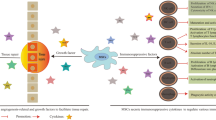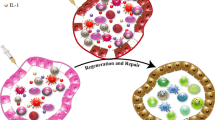Abstract
In this study, we proposed a biological model explaining the progress of autoimmune activation along different stages of systemic lupus erythematosus (SLE). For any upcoming stage of SLE, any new component is introduced, when it is added to the model. Particularly, the interaction of mesenchymal stem cells, with the components of the model, is specified in a way that both the inflammatory and anti-inflammatory functions of these cells would be covered. The biological model is then recapitulated to a model with less complexity that explains the main features of the problem. Later, a 7th-order mathematical model for SLE is proposed, based on this simplified model. Finally, the range of validity of the proposed mathematical model was assessed. For this purpose, we simulated the model and analyzed the simulation results in case of some known behaviors of the disease, such as tolerance breach, the appearance of systemic inflammation, development of clinical signs, and occurrence of flares and improvements. The model was able to reproduce these events, qualitatively.










Similar content being viewed by others
Data availability
No datasets were generated or analyzed during the current study.
Code availability
No specific code has been used for the analysis performed in this research.
References
Abbas AK, Lichtman AH, Pillai S, Abbas AK Cellular and molecular immunology
Akiyama K et al (2012) Mesenchymal-stem-cell-induced immunoregulation involves FAS-ligand-/FAS-mediated T cell apoptosis. Cell Stem Cell 10(5):544–555
Ankrum JA, Ong JF, Karp JM (2014) Mesenchymal stem cells: immune evasive, not immune privileged. Nat Biotechnol 32(3):252–260
Bertsias GK, Salmon JE, Boumpas DT (2010) Therapeutic opportunities in systemic lupus erythematosus: state of the art and prospects for the new decade. Ann Rheum Dis 69(9):1603–1611
Blyuss KB, Nicholson LB (2015) Understanding the roles of activation threshold and infections in the dynamics of autoimmune disease. J Theor Biol 375:13–20
Budu-Grajdeanu P, Schugart RC, Friedman A, Birmingham DJ, Rovin BH (2010) Mathematical framework for human SLE nephritis: disease dynamics and urine biomarkers. Theor Biol Med Model 7:14
Burrell CJ, Howard CR, Murphy FA (2017) Adaptive immune responses to infection. In: Fenner and white’s medical virology. Elsevier, pp 65–76
Carrión F, Nova E, Luz P, Apablaza F, Figueroa F (2011) Opposing effect of mesenchymal stem cells on Th1 and Th17 cell polarization according to the state of CD4+ T cell activation. Immunol Lett 135(1–2):10–16
Carroll MC (2004) The complement system in B cell regulation. Mol Immunol 41(2–3):141–146
Cojocaru M, Cojucaru IM, Silosi I, Vrabie CD (2011) Manifestations of systemic lupus erythematosus [editorial]. Mædica 6(4):330–336
Fatehi F, Kyrychko YN, Blyuss KB (2019) Time-delayed model of autoimmune dynamics. Math Biosci Eng 16(5):5613–5639
Guo Z et al (2009) Fetal BM-derissssssved mesenchymal stem cells promote the expansion of human Th17 cells, but inhibit the production of Th1 cells. Eur J Immunol 39(10):2840–2849
Hao W, Friedman A (2016) Mathematical model on Alzheimer's disease. BMC Syst Biol 10(1):108
Hart SP, Smith JR, Dransfield I (2004) Phagocytosis of opsonized apoptotic cells: roles for ‘old-fashioned’ receptors for antibody and complement. Clin Exp Immunol 135(2):181–185
Herrero C, Pérez-Simón JA (2010) Immunomodulatory effect of mesenchymal stem cells. Braz J Med Biol Res Rev Bras Pesqui Medicas e Biol 43(5):425–430
Jiang X-X et al (2005) Human mesenchymal stem cells inhibit differentiation and function of monocyte-derived dendritic cells. Blood 105(10):4120–4126
Khailaie S, Bahrami F, Janahmadi M, Milanez-Almeida P, Huehn J, Meyer-Hermann M (2013) A mathematical model of immune activation with a unified self-nonself concept. Front Immunol 4:474
Kiefer K, Oropallo MA, Cancro MP, Marshak-Rothstein A (2012) Role of type i interferons in the activation of autoreactive B cells. Immunol Cell Biol 90(5):498–504
Kuznetsov SR (2015) Mathematical model of the humoral immune response: focusing on Th17 autoimmunity. Math Biol Bioinf 10(2):455–472
Li W et al (2012) Mesenchymal stem cells: a double-edged sword in regulating immune responses. Cell Death Differ 19(9):1505–1513
Liu Z, Davidson A (2012) Taming lupus-a new understanding of pathogenesis is leading to clinical advances. Nat Med 18(6):871–882
McKenna MT, Weis JA, Quaranta V, Yankeelov TE (2019) Leveraging mathematical modeling to quantify pharmacokinetic and pharmacodynamic pathways: equivalent dose metric. Front Physiol 10:616
Okeke EB, Uzonna JE (2019) The pivotal role of regulatory T cells in the regulation of innate immune cells. Front Immunol 10:680
Palomares O, Martin-Fontecha M, Lauener R, Traidl-Hoffmann C, Cavkaytar O, Akdis M et al (2014) Regulatory T cells and immune regulation of allergic diseases: roles of IL-10 and TGF-β. Genes and immunity. Genes Immun 8:511
Poole BD, Scofield RH, Harley JB, James JA (2006) Epstein-Barr virus and molecular mimicry in systemic lupus erythematosus. Autoimmunity 39(1):63–70
Rastin M et al (2013) T lymphocyte apoptosis in systemic lupus erythematosus patients. Mashhad Univ Med Sci 16(8):936–941
Regmi S, Pathak S, Kim JO, Yong CS, Jeong JH (2019) Mesenchymal stem cell therapy for the treatment of inflammatory diseases: challenges, opportunities, and future perspectives. Eur J Cell Biol 98:5–8
Rosado MM et al (2015) Inhibition of B-cell proliferation and antibody production by mesenchymal stromal cells is mediated by T cells. Stem Cells Dev 24(1):93–103
Sattar N, McCarey DW, Capell H, McInnes IB (2003) Explaining how ‘high-grade’ systemic inflammation accelerates vascular risk in rheumatoid arthritis. Circulation 108(24):2957–2963
Savill J, Fadok V, Henson P, Haslett C (1993) Phagocyte recognition of cells undergoing apoptosis. Immunol Today 14(3):131–136
Sharma A, Rudra D (2018) Emerging functions of regulatory T cells in tissue homeostasis. Front Immunol 9:883
Spaggiari GM, Abdelrazik H, Becchetti F, Moretta L (2009) MSCs inhibit monocyte-derived DC maturation and function by selectively interfering with the generation of immature DCs: central role of MSC-derived prostaglandin E2. Blood 113(26):6576–6583
Sun L et al (2009) Mesenchymal stem cell transplantation reverses multiorgan dysfunction in systemic lupus erythematosus mice and humans. Stem Cells 27(6):1421–1432
(2013) Systemic inflammation: theoretical and methodological approaches to description of general pathological process model. Part 3. Backgroung for nonsyndromic approach. Patol Fiziol Eksp Ter
Taams LS et al (2005) Modulation of monocyte/macrophage function by human CD4+CD25+ regulatory T cells. Hum Immunol 66(3):222–230
Takayama K et al (2005) Thromboxane A2 and prostaglandin F2alpha mediate inflammatory tachycardia. Nat Med 11(5):562–566
Vignali DAA, Collison LW, Workman CJ (2008) How regulatory T cells work. Nat Rev Immunol 8(7):523–532
Wallace D, Hahn B (2019) Dubois’ lupus erythematosus and related syndromes. Elsevier 1:44–53
Wang D et al (2018) A long-term follow-up study of allogeneic mesenchymal stem/stromal cell transplantation in patients with drug-resistant systemic lupus erythematosus. Stem Cell Rep 10(3):933–941
Wei HC, Yu JL, Hsu CY (2017) Periodically pulsed immunotherapy in a mathematical model of tumor, CD4 + T cells, and antitumor cytokine interactions. Comput Math Methods Med 2017:2906282
Zhang W, Wahl LM, Yu P (2014) Modeling and analysis of recurrent autoimmune disease. SIAM J Appl Math 74(6):1998–2025
Zharkova O, Celhar T, Cravens PD, Satterthwaite AB, Fairhurst AM, Davis LS (2017) Pathways leading to an immunological disease: systemic lupus erythematosus. Rheumatology (oxford) 56(1):I55-i66
Zotova NV, Chereshnev VA, Gusev EY (2016) Systemic inflammation: methodological approaches to identification of the common pathological process. PLoS ONE 11(5):e0155138
Acknowledgements
We greatly thank Dr. Nariman Mosaffa, Professor of immunology from the medical school of Shahid Beheshti university. Also, Dr. Anvar Fathollahi from the medical school of Shahid Beheshti university helped us to understand some immunological aspects of SLE.
Funding
Not applicable.
Author information
Authors and Affiliations
Contributions
AY wrote the main text of the manuscript. FB supervised AY to develop the model, especially the mathematical aspect. AP helped to develop the model, especially the immunological aspect. And RM helped to format and edit the manuscript proportionate to biology-related papers. All of the authors contributed to reviewing and editing the manuscript.
Corresponding author
Ethics declarations
Conflict of interest
The authors of this manuscript have no conflict of interest.
Ethics approval
Not applicable.
Consent to participate
No person but the authors and the researchers who are appreciated in the acknowledgment section participated in this research.
Consent for publication
All of the authors of this manuscript agree to publish this article in this journal.
Additional information
Publisher's Note
Springer Nature remains neutral with regard to jurisdictional claims in published maps and institutional affiliations.
Rights and permissions
Springer Nature or its licensor (e.g. a society or other partner) holds exclusive rights to this article under a publishing agreement with the author(s) or other rightsholder(s); author self-archiving of the accepted manuscript version of this article is solely governed by the terms of such publishing agreement and applicable law.
About this article
Cite this article
Yazdani, A., Bahrami, F., Pourgholaminejad, A. et al. A biological and a mathematical model of SLE treated by mesenchymal stem cells covering all the stages of the disease. Theory Biosci. 142, 167–179 (2023). https://doi.org/10.1007/s12064-023-00390-4
Received:
Accepted:
Published:
Issue Date:
DOI: https://doi.org/10.1007/s12064-023-00390-4




